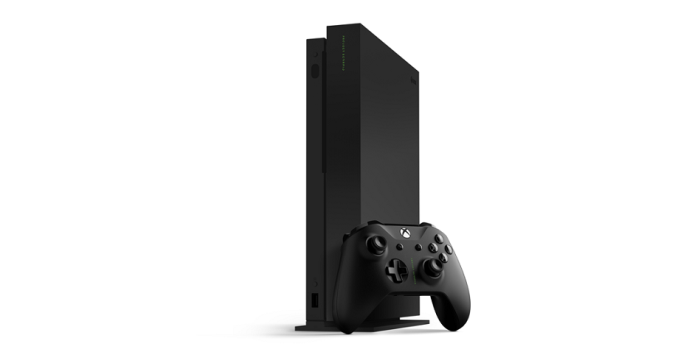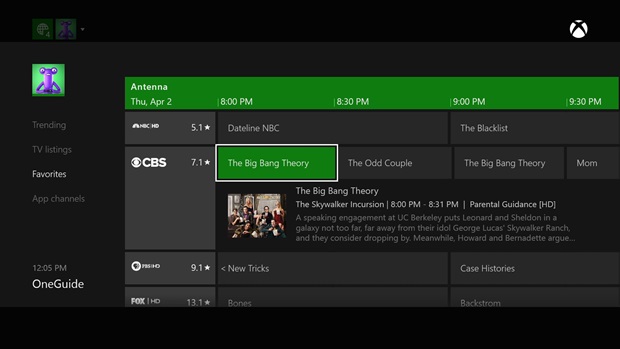The Xbox One X Review: Putting A Spotlight On Gaming
by Brett Howse on November 3, 2017 3:01 AM EST- Posted in
- Consoles
- Microsoft
- Xbox One
- Xbox
- Xbox One X
Power Usage
There’s a lot of performance on tap in the Xbox One X, which never comes with no strings attached. Like the Xbox One S, the APU inside is built on TSMC’s 16 nm FinFET process, which should help keep power usage under control. In addition, the Xbox One X is outfitted with a power supply that Microsoft equates to an 80 Plus Gold unit, which means it should be 90% efficient at 50% load with a 115 V source, and there shouldn’t be too much extra power wasted from the PSU converting AC voltage.
There’s several scenarios we tested for power usage:
Off – Xbox One X is powered off in Energy Savings mode, which means standby mode is disabled.
Standby – Xbox One X is powered off in Instant-On mode, which allows background updating and voice activation enabled (if supported).
Idle – Ethernet connected, no disc in the drive, system idling at dashboard.
Load (UHD BD Playback) – Ethernet connected, UHD Blu-Ray disc in the drive playing Planet Earth II, compared to The Hobbit on Blu-Ray on the original Xbox One.
Load (GoW4) – Ethernet connected, no disc in the drive, playing Gears of War 4 in UHD/HDR.
Load (The Wolf Among Us) – Ethernet connected, no disc in the drive, playing The Wolf Among Us in FHD SDR.
We’ve been able to compare against the original Xbox One, although not the S model as we didn’t have one on hand. The Wolf Among Us was chosen as an older game which caps at 1080p and SDR, and Gears of War 4 shows the power draw at full 4K HDR rendering. The comparison against the original for this game will of course be for the 1080p version though, since that’s the max it supports.
| Power Consumption Comparions | |||||||
| Total System Power | Energy-Saving | Instant-On | Idle | Load (UHD BD) | Load (GoW4) | Load (The Wolf Among Us) | |
| Xbox One | < 2W | 14.2W | 53W | 80W | 107W | 102W | |
| Xbox One X | < 1W | 10W | 56W | 64W | 172W | 101W | |
As with the original Xbox One, when Instant On is disabled, the console is practically fully off. There’s a small amount of draw, but overall, not very much. Most people that use the console are going to likely want it in Instant On mode though, so games and the console can update while the system is off, as well as to provide a much quicker startup time, and games can remain loaded in RAM. In Standby mode, power draw is reasonable at 10 W, which is lower than the original console when it first launched. It’s still a fair bit of power, but when you factor in that it needs to keep 12 GB of GDDR5 memory powered up (among other things), it is not unreasonable to expect this amount of power draw.
Idling at the dashboard draws around 55 W, and to add to that, most non-gaming tasks don’t add very much to this total, if any. If you’re using your Xbox to passthrough HDMI from a cable box, it will take this same power draw. Maybe this would be an impossible pipe dream, but it would be nice to see the Xbox One also pass through HDMI when it is in Standby mode.
Playing back a UHD Blu-Ray (standard Blu-Ray on the original Xbox One) was a tiny bit higher than idle, which is good to see. Some of the draw would be the disc drive itself, but a lot of the playback would be offloaded to fixed function hardware in the media block so it’s not surprising to see it so close to idle.
Clearly gaming on older Xbox One games is not much of a chore for the Xbox One X, since the power draw is only about 50 W over idle. But, when gaming with an Xbox One X Enhanced title, such as Gears of War 4, the power draw jumps significantly to 172 W as the peak observed. This is quite a jump over the original console, and makes the cooling system, which is barely audible even under these loads, even more impressive. Compared to a high-end gaming PC though, the power draw is quite a bit less.












128 Comments
View All Comments
4everalone - Friday, November 3, 2017 - link
No sir! That happens due to an infra-red blaster on the kinect. So basically, no Kinect, no device control. Its mind boggling to me till this day that they failed to incorporate HDMI-CEC despite all of the media capability touted.Brett Howse - Friday, November 3, 2017 - link
Don't believe there is any CEC support still. Just IR blasters.gorman42 - Friday, November 3, 2017 - link
In the "Enjoying Meda" section you correctly mention the HDR problem with Netflix but completely fail to describe the situation with non-existant refresh rate switching. While we have specific settings to allow apps to switch to either 24Hz or 50Hz, according to content played back, those are useless for both Netflix and Amazon Prime Video (and for all other streaming services, such as Now TV in Europe).To add insult to injury, Apple has just announced a fix for this situation for their Apple TV product: http://www.avsforum.com/apple-tv-4k-will-automatic...
Brett Howse - Saturday, November 4, 2017 - link
Xbox supports all of this so it's again on the dev.BrokenCrayons - Friday, November 3, 2017 - link
So if I understand this correctly, the One X will render everything in 4k and downsample to the screen resolution rather than rendering and displaying at panel res. Is that right?InlineV - Friday, November 3, 2017 - link
In games, it is supersampling rendered resolution down to native resolution (2160p, 1440p or 1080p). For example, Titanfall 2 is able to render up to 6k before it is supersampled down to 4k. I don't know if it renders up to 6k before it is supersampled for 1440p or 1080p but it wouldn't surprise me if it did.BrokenCrayons - Friday, November 3, 2017 - link
Thanks! I was just curious about what it was doing behind the scenes before pumping the image out to the screen.novastar78 - Monday, November 6, 2017 - link
They already have had the technique in their drivers for some time, it's called VSR (Vitual Super Resolution). The scene is fully rendered at the higher res and then downsized.alistair.brogan - Friday, November 3, 2017 - link
yes but a ps4 pro would just give you a 1080p image, and your 1440p monitor would upscale itxbox one x downscales a 4k and outputs 1440p, and no monitor scaling is required, but the feature isn't available yet
jardows2 - Friday, November 3, 2017 - link
I like the development of "revisions" rather than completely "new" consoles. With the Xbox, this appears to be a convergence of console gaming and PC gaming. With the PC, games don't have to be re-written by the developers or re-purchased every time there is a CPU or GPU upgrade. This seems to be the path MS is taking with the XBox, and I believe it will turn out very well for them.